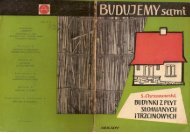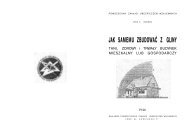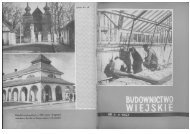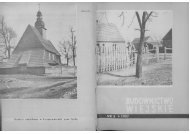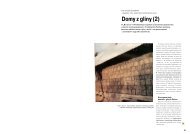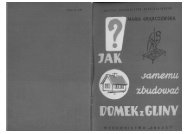by Athena and Bill Steen - Cohabitat
by Athena and Bill Steen - Cohabitat
by Athena and Bill Steen - Cohabitat
You also want an ePaper? Increase the reach of your titles
YUMPU automatically turns print PDFs into web optimized ePapers that Google loves.
Additional layers<br />
When this first layer is completed, it can be followed with other<br />
layer or layers. If the finished look of the floor is not so critical, this<br />
can be the final layer. More care can be taken to level the surface.<br />
Dragging a board across the surface to screed it as done with concrete<br />
is a good method<br />
Tamping will produce edges, but these can be smoothed or<br />
softened with a trowel <strong>and</strong> retamped to create a reasonably level<br />
surface If this is the final layer, it should be applied slightly higher<br />
than the intended height of the floor as tamping will compact the<br />
floor mixture approximately 20 to 30%.<br />
Final layer<br />
If the surface of the final layer is not smooth enough, it can be<br />
topped with a very thin troweled-on application of the same soil<br />
mixture, screened with 1/8* hardware cloth. It is applied in the same<br />
way that one would apply a finish plaster to a wall. Care should be<br />
taken to make sure that the previous layer is well moistened to ensure<br />
a good bond between the two.<br />
A hybrid version of Method 1 <strong>and</strong> 2 can also be used for the<br />
final layer. A1/2 inch layer of a clay/soil mix, as in Method 1, can be<br />
troweled on top of the tamped layers.<br />
Method 3<br />
This is the fastest method of the three, but less finished with more<br />
texture than methods 1 <strong>and</strong> 2. It is also suitable for outdoor surfaces<br />
in dry climates.<br />
Soil Mixture<br />
This method uses psyllium seed as a stabilizer in combination<br />
with a s<strong>and</strong>y soil mix or another material that has a fair amount of<br />
aggregate. Psyllium acts like clay or cement, it coats small pieces of<br />
aggregate <strong>and</strong> triads them together, ft is often used with crushed granite<br />
for outdoor walkways.<br />
Ground psyllium seed (see resource section) is dry mixed at<br />
the rate of 1 lb. per 10 square feet to create a 2 inch thick floor. For a<br />
3 inch thick floor, 1 lb. per 7 square feet is needed. A mortar mixer or<br />
concrete mixer is good for larger quantities.<br />
Application<br />
This mix is spread dry over the base layer that has been soaked<br />
with water. It is then leveled <strong>and</strong> compacted with a roller, as is typically<br />
used for l<strong>and</strong>scaping.<br />
The soil <strong>and</strong> psyllium mix is then saturated with water <strong>by</strong> using<br />
a spray nozzle that has a mist option. Applying the water in a mist<br />
does not disturb the prepared surface of the floor. It is essential to<br />
moisten the soil mixture so that the full depth of the material receives<br />
water. After the surface water disappears, the surface can be further<br />
compacted with a roller.<br />
The top layer can be troweled lightly to help seal the surface of<br />
the floor <strong>and</strong> to produce a smooth surface. Too much pressure will<br />
tend to float the psyllium to the top <strong>and</strong> weaken the bottom layers.<br />
The surface can be misted or moistened slightly to facilitate the<br />
process.<br />
It is possible to apply the psyllium in a wet mix with a trowel,<br />
like in method 1, but it can be difficult to control the consistency of<br />
the soil psyllium mix. Which has a tendency to continue absorbing<br />
moisture <strong>and</strong> consequently continues becoming drier <strong>and</strong> changing<br />
in consistency. However, some experimentation may yield good<br />
results. Small samples that we have created using this method have<br />
yielded good results.<br />
Volume of soil needed for the finished floor layer<br />
At adepth of 1 inch, approximately 1 ton of soil mixture will be<br />
needed for every 200 square feet; for 2 inches, 1 ton per 200 square<br />
feet is needed; for 3 inches, 1 ton per 65 square feet.




